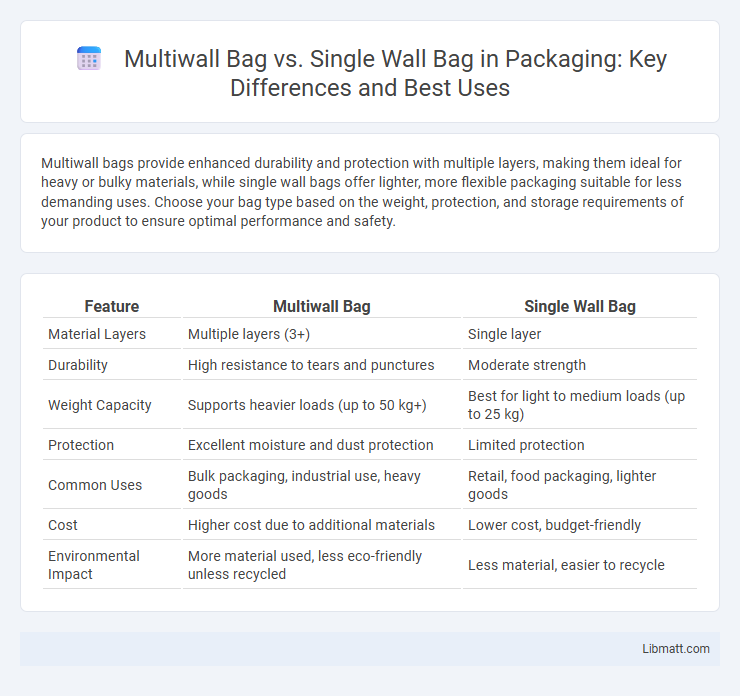Multiwall bags provide enhanced durability and protection with multiple layers, making them ideal for heavy or bulky materials, while single wall bags offer lighter, more flexible packaging suitable for less demanding uses. Choose your bag type based on the weight, protection, and storage requirements of your product to ensure optimal performance and safety.
Table of Comparison
| Feature | Multiwall Bag | Single Wall Bag |
|---|---|---|
| Material Layers | Multiple layers (3+) | Single layer |
| Durability | High resistance to tears and punctures | Moderate strength |
| Weight Capacity | Supports heavier loads (up to 50 kg+) | Best for light to medium loads (up to 25 kg) |
| Protection | Excellent moisture and dust protection | Limited protection |
| Common Uses | Bulk packaging, industrial use, heavy goods | Retail, food packaging, lighter goods |
| Cost | Higher cost due to additional materials | Lower cost, budget-friendly |
| Environmental Impact | More material used, less eco-friendly unless recycled | Less material, easier to recycle |
Introduction to Multiwall and Single Wall Bags
Multiwall bags consist of multiple layers of paper or other materials that provide enhanced strength, durability, and protection for heavy or bulky products compared to single wall bags. Single wall bags are made from a single layer, offering sufficient protection for lighter, less fragile goods but with less resistance to punctures and moisture. Choosing between multiwall and single wall bags depends on the product's weight, handling requirements, and environmental exposure during storage and transportation.
Key Differences Between Multiwall and Single Wall Bags
Multiwall bags consist of multiple layers of kraft paper or plastic films, providing enhanced strength, durability, and moisture resistance compared to single wall bags, which have only one layer. Multiwall bags offer superior protection for heavy or abrasive materials such as chemicals, cement, or food powders, while single wall bags are better suited for lightweight, dry products. Understanding these key differences ensures you select the appropriate bag to protect your goods during storage and transportation.
Construction and Materials Used
Multiwall bags consist of several layers of kraft paper, plastic films, or foil, which provide enhanced strength, puncture resistance, and moisture protection compared to single wall bags. Single wall bags are typically made from a single layer of kraft paper or polyethylene, offering lightweight protection suited for less demanding applications. The multi-layered construction of multiwall bags ensures durability for heavy-duty or bulk packaging, while single wall bags prioritize economy and simplicity.
Strength and Durability Comparison
Multiwall bags offer superior strength and durability compared to single wall bags due to their multiple layers that enhance resistance to tearing, abrasion, and punctures. They are ideal for heavy-duty applications requiring enhanced protection against environmental factors and rough handling. Your choice should depend on the weight and type of contents to ensure optimal performance and longevity.
Common Applications for Multiwall Bags
Multiwall bags are ideal for packaging heavy or granular materials such as cement, chemicals, grains, and fertilizers due to their enhanced strength and multiple layers that provide superior protection against moisture and punctures. These bags are commonly used in industrial, agricultural, and construction sectors where durability and resistance to tearing are critical. Choosing multiwall bags ensures your products remain secure during storage and transportation, minimizing product loss and contamination.
Industries Using Single Wall Bags
Industries using single wall bags include agriculture, construction, and food packaging, where lightweight and cost-effective solutions are essential. These bags provide adequate protection for products like grains, seeds, cement, and flour while enabling easy handling and efficient storage. Single wall bags offer versatility and durability for industries that do not require the enhanced strength and moisture resistance of multiwall bags.
Cost Comparison: Multiwall vs Single Wall Bags
Multiwall bags typically have a higher initial cost compared to single wall bags due to their layered construction, which provides enhanced durability and protection for heavy or bulky products. Single wall bags are more cost-effective for lightweight or less demanding applications, reducing material and production expenses. Choosing between the two depends on balancing upfront costs with the required strength and product safety during transportation and storage.
Environmental Impact and Sustainability
Multiwall bags offer enhanced sustainability due to their ability to be manufactured from recycled materials and their superior durability, which extends product life and reduces waste. Single wall bags, often made from less robust materials, typically have a shorter lifecycle and generate more packaging waste, contributing negatively to environmental impact. The choice of multiwall bags supports eco-friendly packaging solutions by minimizing landfill contributions and promoting resource efficiency in industrial and consumer applications.
Selecting the Right Bag for Your Needs
Choosing between a multiwall bag and a single wall bag depends on the weight, durability, and protection requirements of your product. Multiwall bags offer enhanced strength and moisture resistance, making them ideal for heavy or bulky materials like cement, chemicals, or grains. Your decision should align with the load capacity and environmental conditions to ensure product safety and cost efficiency.
Conclusion: Which Bag Should You Choose?
Multiwall bags offer superior strength, puncture resistance, and moisture protection, making them ideal for heavy-duty industrial use and long-term storage. Single wall bags are more cost-effective, lightweight, and suitable for short-term packaging or less demanding applications. Choose multiwall bags for durable, high-performance needs and single wall bags when budget and light applications are the priority.
Multiwall bag vs single wall bag Infographic

 libmatt.com
libmatt.com